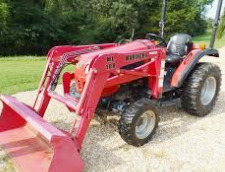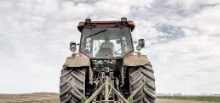________________________________________________________________________________________
| Home / Farm Tractors / Mahindra Tractors / Mahindra 2810 |
Mahindra 2810 Troubleshooting
 The
Mahindra 2810 compact utility tractor was manufactured by TYM built between 2002
and 2006. The Mahindra 2810 tractor is powered by Daedong 3A139 4-stroke
3-cylinder indirect injection naturally aspirated diesel engine. A 85.4 cubic
inches (1.4 L) engine has a cylinder bore of 3.15" (80 mm), piston stroke of
3.65" (92 mm), and rated power of 28 hp (20.9 kW). The Mahindra 2810 is fitted
with a 2 transmission options: 12x12 full synchromesh transmission, or 3-range
hydrostatic transmission.
The
Mahindra 2810 compact utility tractor was manufactured by TYM built between 2002
and 2006. The Mahindra 2810 tractor is powered by Daedong 3A139 4-stroke
3-cylinder indirect injection naturally aspirated diesel engine. A 85.4 cubic
inches (1.4 L) engine has a cylinder bore of 3.15" (80 mm), piston stroke of
3.65" (92 mm), and rated power of 28 hp (20.9 kW). The Mahindra 2810 is fitted
with a 2 transmission options: 12x12 full synchromesh transmission, or 3-range
hydrostatic transmission.
The maximum forward speed - 13.1 mph (21.1 km/h), maximum reverse speed - 13 mph (20.8 km/h). The open center hydraulic system includes a gear pump with rated fluid flow of 5.9 gal/min (22.5 l/min). The tractor is equipped with a hydrostatic power steering system, wet disc brakes, 7.00x16 (AG) or 25x8.50-14 (Turf) front tyres, and 11.2x24 (AG) or 13.6x16 (Turf) rear tyres. The wheelbase is 64.5" (1640 mm). The tractor is compatible with Mahindra ML108 front end-loader with a lift capacity to full height of 1100 lbs (500 kg).
| Diesel Engine Troubleshooting |
| Engine difficult to start or will not start |
There is air in the fuel system - Bleed the system.
Fuel filter element is dirty - Service the filter.
Defective injection nozzle - Test injection nozzles and change if necessary.
Water in the fuel system - Change fuel and repair fuel system.
Excessive valve clearance - Adjust valve clearance according to specifications.
Fuel injection pump is not operating properly - Replace or rebuild injection pump.
| Engine stalls after starting |
Clogged air filter - Change air filter element.
Fuel filter plugging - Change filter element.
Problems with fuel injection pump tightness - Inspect fuel injection pump for leaks.
Damaged or clogged injectors - Replace or clean fuel injectors.
Fuel injection pump is not working correctly - Replace injection pump or repair it.
| Engine stops unexpectedly during operation |
Low coolant temperature - Warm up to required temperature.
Fuel filter element clogging - Change filter element.
Air in fuel tank - Bleed fuel tank.
Clogged or burnt injection nozzle - Inspect nozzles and replace if necessary.
Incorrect adjustment of fuel injection pump timing - Set it up as required.
| Engine stops while idle |
Low idle speed setting is not correct - Adjust low idle speed.
Fuel injection pump is faulty - Repair or install a new fuel pump.
Dirty or defective injectors - Test and replace fuel injectors if necessary.
Valve clearance is not correct - Check and adjust as required.
| Engine lacks power |
Dirty air filter element - Clean or change.
Clogged or burnt injection nozzle - Test injection nozzles and change if necessary.
Improper fuel injection pressure - Adjust pressure to proper level.
Improper valve clearance - Have it adjusted.
Incorrect low idle setting - Adjust as required.
Fuel lines or hoses are dirty - Clean fuel lines and hoses.
Worn cylinder head gasket - Install a new gasket.
Piston rings are leaking or defective - Piston rings replacement required.
| Engine overheating |
Insufficient coolant fluid - The cooling system needs to be refilled and checked for faults.
Engine oil level low - Checking oil level and add if necessary.
Dirty radiator core or defective radiator cap - Clean radiator or install new cap.
Broken or loose fan belt - Change as required.
Diesel engine is overloaded - Load reducing required.
| Low oil pressure |
Lack of oil - Checking oil level and add if necessary.
Dirty oil filter element - Service or replace engine oil filter.
Oil grade or viscosity is incorrect - Use oil of proper viscosity.
Crankshaft bearing has incorrect oil clearance - Bearings need to be reinstalled.
Oil pump is damaged - Inspect and change as required.
| Engine knocks or noises |
Lack of engine oil - Add oil to the engine crankcase.
Engine is not preheated - Warm up the engine.
Fuel injection pump timing is not adjusted - Adjust according to specifications.
Improperly adjusted low idle speed - Adjust low idling as recommended.
Fuel injectors are dirty or defective - Replace fuel injectors.
Misaligned or faulty connecting rod - Align or change connecting rod.
Scored or worn pistons - Have pistons replaced.
| Transmission Troubleshooting |
| Low transmission oil pressure |
Insufficient transmission oil - Add oil to the transmission housing.
Plugged transmission oil filter (if equipped) - Clean or replace the transmission filter.
Stuck relief valve - Change relief valve.
| Excessive transmission noise |
Insufficient transmission fluid - Checking transmission fluid level and add if necessary.
Transmission fluid is contaminated - Fill up with fresh transmission fluid.
Incorrect backlash or gears are worn - Install new gears and adjust backlash properly.
Worn or broken bearings - Faulty bearings should be changed.
Shift forks are bent or worn out - Replace the shift forks.
Worn or stuck shaft splines - Change the shaft.
| Gears are hard to shift |
Corroded or worn gear shift linkage - Lubricate or replace the shift linkage.
Shift forks are bent or worn out - Change defective shift forks.
Gear shifting mechanism is defective - Defective parts must be replaced.
Malfunction or incorrect clutch adjustment - Adjust clutch or replace if required.
| External oil leaks |
High transmission fluid level - Drain the excess fluid.
Seals or gaskets are worn - Change defective seal or gaskets.
| Hydrostatic Transmission Troubleshooting |
| HST transmission makes noise |
Low transmission oil level or contaminated oil - Add oil to proper level or pour fresh transmission oil.
Speed control pedal linkage is bent or not adjusted - Adjust or repair linkage.
Relief valve malfunction - Replace valve as required.
Transmission overloaded - Load needs to be reduced.
Damaged or worn components of hydrostatic transmission - Replace or repair defective components.
| Loss of power |
Lack of transmission fluid - Check and refill the transmission fluid.
Stuck relief valve - Change relief valve.
Speed control pedal linkage is bent or not adjusted - Adjust or replace linkage.
| Transmission fluid overheated |
Lack of transmission fluid - Fill the transmission housing to proper fluid level.
Dirty transmission fluid filter element - Clean or change transmission fluid filter.
Damaged or clogged cooling components - Check all cooling components and repair or change if required.
Transmission overload - Reduce loading.
| Transmission fluid leaks |
Seals or gaskets are worn - Install new seal or gaskets.
High internal transmission case pressure - Change defective parts.
Oil return tube is plugged - Clean or replace the tube.
| Hydraulics Troubleshooting |
| Hydraulic fluid pressure too low |
Hydraulic fluid level low - Fill up the hydraulic fluid.
Clogged hydraulic oil filter - Change hydraulic filter element or clean if necessary.
Defective hydraulic pump - Install a new hydraulic fluid pump.
Not adjusted hydraulic control valve - Need to adjust.
Hydraulic cylinder is faulty - Repair or replace hydraulic cylinder.
Leaks in hydraulic pipes - Inspect hydraulic system for leaks and repair it.
| Hydraulic system overheated |
Damaged main relief valve - Relief valve must be changed.
Wrong hydraulic fluid type - Pour the proper type of fluid.
Hydraulic fluid is contaminated - Fill up with new hydraulic fluid.
Air in the hydraulic system - Air bleeding.
| Hitch does not raise or raises very slowly |
Heavy load on the hitch - Reduce hitch load.
Hydraulic fluid is insufficient - Checking hydraulic fluid level and add if necessary.
Dirty hydraulic oil filter element - Clean or replace the hydraulic filter.
Hydraulic pump is faulty - Install a new hydraulic fluid pump.
Damaged main relief valve - Change relief valve.
Hydraulic spool valve block is defective - Repair or replace the valve.
Damaged hydraulic cylinder - Repair or change hydraulic cylinder.
Suction line is loose or broken - Replace or repair.
| Three-point hitch cannot be dropped or dropping is too slow |
Incorrect adjusted hydraulic spool valve - Adjust the spool valve correctly.
Hydraulic cylinder not working - Repair or install a new hydraulic cylinder.
Hitch is out of adjustment - Adjustment is required.
Damaged lift arm shaft - Replace the shaft.
| Hitch jerks when drop or lift |
Air in hydraulic lines - Bleed hydraulic lines.
Hydraulic fluid is dirty - Hydraulic fluid change required.
Hydraulic pump not working - Replace or repair hydraulic oil pump.
Faulty hydraulic control valve - Install a new valve or repair it.
Damaged hydraulic cylinder - Repair or replace hydraulic cylinder.
| Steering Troubleshooting |
| Heavy steering |
Worn or incorrectly fitted steering column - Replace the steering column or refit it correctly.
Air in steering hydraulic system - Bleed air.
Improper toe-in - Check and adjust toe-in.
Uneven wear on front tires - Replace the tires.
Steering pump not working - Check the steering pump and replace if necessary.
Pump flow control valve is worn or stuck - Replace or clean flow control valve.
Not enough steering oil - Check oil level and add steering oil as required.
| Steering wheel has too much free-play |
Worn steering column shaft or coupling - Change faulty component.
Steering pump malfunction - Check the steering pump and replace if necessary.
Steering linkage assembly is worn or loose - Change or repair steering linkage.
| Tractor is pulling to right or left |
Uneven tyre pressure - Inflate the tyres properly.
Not adjusted toe-in - Check toe-in and correct.
Loose or worn steering linkage components - Check and replace as required.
Front wheel bearings are defective or improperly adjusted - Adjust correctly or change bearings.
| Electrical System Troubleshooting |
| Battery won’t charge |
Wiring connections are corroded or loose - Tighten or service connections.
Faulty electrical terminal connectors - Terminal connectors need to be changed.
Battery is worn - Battery replacement required.
Damaged or loose belt - Change belt or adjust belt tension.
| Starter motor turns slow |
Low battery voltage - Charge the battery.
Battery is not holding charge - Battery needs to be serviced or replaced.
Corroded battery terminals or disconnected wires - Connect wiring correctly or install new terminals.
| Starter is not cranking |
Battery is drained or worn - Replace or charge as required.
Battery wiring is disconnected or improperly connected - Inspect wiring and connect as required.
Low battery voltage - Charge the battery.
Faulty starter motor - Repair or replace starter.
________________________________________________________________________________________
________________________________________________________________________________________
| Farm Tractors Technical Specifications |
